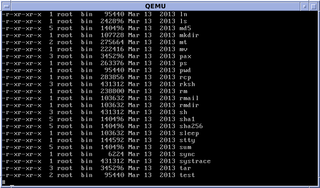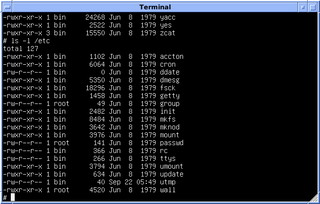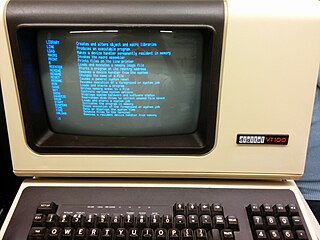
In Unix and Unix-like operating systems, chmod is the command and system call which is used to change the access permissions of file system objects. It is also used to change special mode flags. The request is filtered by the umask. The name is an abbreviation of change mode.

A man page is a form of software documentation usually found on a Unix or Unix-like operating system. Topics covered include computer programs, formal standards and conventions, and even abstract concepts. A user may invoke a man page by issuing the man command.

In computing, ls is a command to list computer files in Unix and Unix-like operating systems. ls is specified by POSIX and the Single UNIX Specification. When invoked without any arguments, ls lists the files in the current working directory. The command is also available in the EFI shell. In other environments, such as DOS, OS/2, and Microsoft Windows, similar functionality is provided by the dir command. The numerical computing environments MATLAB and GNU Octave include an ls function with similar functionality.

uname is a computer program in Unix and Unix-like computer operating systems that prints the name, version and other details about the current machine and the operating system running on it.
Uptime is a measure of system reliability, expressed as the percentage of time a machine, typically a computer, has been working and available. Uptime is the opposite of downtime.

Seventh Edition Unix, also called Version 7 Unix, Version 7 or just V7, was an important early release of the Unix operating system. V7, released in 1979, was the last Bell Laboratories release to see widespread distribution before the commercialization of Unix by AT&T Corporation in the early 1980s. V7 was originally developed for Digital Equipment Corporation's PDP-11 minicomputers and was later ported to other platforms.

For computer file systems, fdisk is a command-line utility that provides disk partitioning functions. It is available in DOS, DR FlexOS, IBM OS/2, and Microsoft Windows operating systems, and in certain ports of FreeBSD, NetBSD, OpenBSD, DragonFly BSD and macOS for compatibility reasons. In versions of the Windows NT operating system line from Windows 2000 onwards, fdisk is replaced by a more advanced tool called diskpart. Similar utilities exist for Unix-like systems, for example, BSD disklabel.
The software utility cron is a time-based job scheduler in Unix-like computer operating systems. Users that set up and maintain software environments use cron to schedule jobs to run periodically at fixed times, dates, or intervals. It typically automates system maintenance or administration—though its general-purpose nature makes it useful for things like downloading files from the Internet and downloading email at regular intervals. The origin of the name cron is from the Greek word for time, χρόνος (chronos).

tr is a command in Unix and Unix-like operating systems. It is an abbreviation of translate or transliterate, indicating its operation of replacing or removing specific characters in its input data set.
The Berkeley r-commands are a suite of computer programs designed to enable users of one Unix system to log in or issue commands to another Unix computer via TCP/IP computer network. The r-commands were developed in 1982 by the Computer Systems Research Group at the University of California, Berkeley, based on an early implementation of TCP/IP.

In some operating systems, including Unix, a pseudoterminal, pseudotty, or PTY is a pair of pseudo-devices, one of which, the slave, emulates a hardware text terminal device, the other of which, the master, provides the means by which a terminal emulator process controls the slave.

In Unix-based computer operating systems, init is the first process started during booting of the computer system. Init is a daemon process that continues running until the system is shut down. It is the direct or indirect ancestor of all other processes and automatically adopts all orphaned processes. Init is started by the kernel during the booting process; a kernel panic will occur if the kernel is unable to start it. Init is typically assigned process identifier 1.

LAMP is an archetypal model of web service stacks, named as an acronym of the names of its original four open-source components: the Linux operating system, the Apache HTTP Server, the MySQL relational database management system (RDBMS), and the PHP programming language. The LAMP components are largely interchangeable and not limited to the original selection. As a solution stack, LAMP is suitable for building dynamic web sites and web applications.
In computing, mount is a command in various operating systems. Before a user can access a file on a Unix-like machine, the file system that contains it needs to be mounted with the mount command. Frequently mount is used for SD card, USB storage, DVD and other removable storage devices. The command is also available in the EFI shell.
In computing, a dynamic linker is the part of an operating system that loads and links the shared libraries needed by an executable when it is executed, by copying the content of libraries from persistent storage to RAM, filling jump tables and relocating pointers. The specific operating system and executable format determine how the dynamic linker functions and how it is implemented.
In computing, whoami is a command found on most Unix-like operating systems, Intel iRMX 86, every Microsoft Windows operating system since Windows Server 2003, and on ReactOS. It is a concatenation of the words "Who am I?" and prints the effective username of the current user when invoked.
sha1sum is a computer program that calculates and verifies SHA-1 hashes. It is commonly used to verify the integrity of files. It is installed by default in most Unix-like operating systems. Variants include shasum, sha224sum, sha256sum, sha384sum and sha512sum, which use a specific SHA-2 hash function, and sha3sum. Versions for Microsoft Windows also exist, and the ActivePerl distribution includes a perl implementation of shasum. On FreeBSD and OpenBSD the utilities are called md5, sha1, sha256, sha512. These versions offer slightly different options and features. Additionally, FreeBSD offers the "SKEIN" family of message digests.

In computing, the print command provides single-user print spooling capability in a number of operating systems. It is roughly similar to that provided by the UNIX System V lp and BSD lpr print spooler systems.

Unix is a family of multitasking, multiuser computer operating systems that derive from the original AT&T Unix, development starting in the 1970s at the Bell Labs research center by Ken Thompson, Dennis Ritchie, and others.
In computing, tty is a command in Unix and Unix-like operating systems to print the file name of the terminal connected to standard input.











